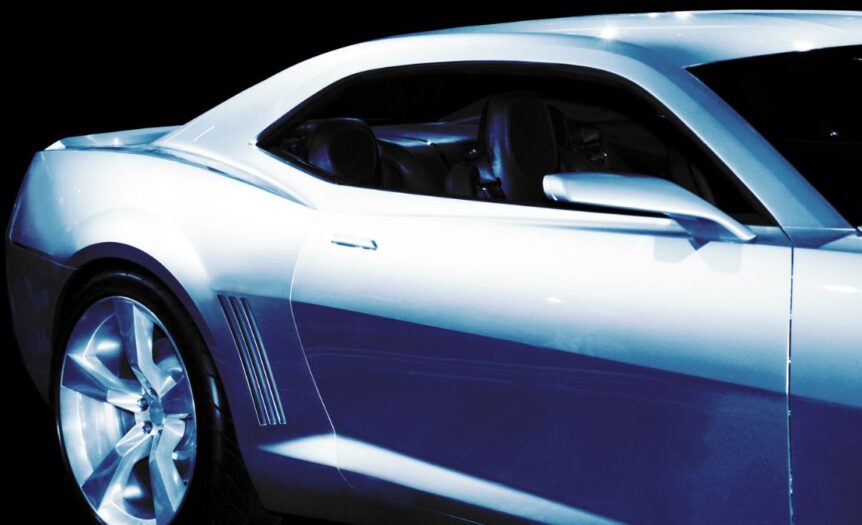During World War II, many Americans fighting overseas were supplied with “general purpose” vehicles thanks to a collaborative effort by Henry Ford, Willys-Overland Motors, and other industry-leading car manufacturers. These durable and popular trucks were often marked with the abbreviation “GP” and referred to as “jeeps” when communicating with other soldiers. Consequently, the Willys-Overland adopted this catchy nickname when they created civilian models of the GPs, eventually leading to the creation of the Jeep brand—one of the most iconic automotive companies of all time! Read on to learn three more interesting facts and stories that shed light on the meaning behind different car model names.
The Ford Bronco
Willys-Overland Motors wasn’t the only popular automotive brand that released civilian Jeeps following World War II. In fact, Ford experimented with plenty of similar 4x4s that utilized nearly identical components and boasted comparable performance. However, the release of the Ford Bronco in 1966 proved that this company could compete with YJs (early Wranglers), Land Rovers, and other popular models. But how did this highly recognizable off-roader get the name “Bronco?”
During the early days of the Ford Bronco’s storied evolution, the creative team behind this Ford SUV preferred the name “GOAT.” This was an acronym for “go-over-all-terrain” and described the advanced off-roading capabilities of the eventual Bronco. Some Ford higher-ups even suggested the name “Wrangler” to capitalize on the popularity of cowboys and Western Americana! Ultimately, Ford decided to name their newest SUV the Bronco to complement their other popular model released in 1966—the Ford Mustang! Interestingly enough, the Mustang was named after the P51 single-seat Mustang fighter plane and not the horse, but the Pony Car craze of the ’60s ensured “Bronco” would be successful in the market.
The Chevrolet Camaro
On the topic of Ford Mustangs, it’s worth mentioning the meaning behind the name of their biggest competitor. Many automotive enthusiasts believe the word draws inspiration from a French term for “comrade.” When the first Camaro was released in 1966, Chevy executives described a Camaro as a predatory animal that loved to eat mustangs. Of course, this was a lighthearted jab directed toward their contemporaries at Ford. Ultimately, its true meaning is quite anticlimactic; Chevrolet manufactured the name because it started with a “c” and, in their opinion, paired well with the Pony Car design.
Volkswagen Golf
While many American-made cars are named after horses and other animals, foreign cars often choose less traditional names. In the case of the Volkswagen Golf, this name is not actually a nod to the popular sport. Rather, this hatchback draws inspiration from the Gulf Stream, and “Golf” is simply the brand’s spelling choice. In fact, many of their vehicles are named after geographic winds, including the Jetta (Jet Stream), Polo (Polar Winds), Passat (Trade Winds), and Scirocco (the Mediterranean Sirocco winds). The design team behind the Volkswagen Golf does include elements related to the sport, such as adding a golf-ball-like shifting knob and tartan fabric (found in the Golf GTI).
There is plenty of hidden meaning behind different car model names worth learning about further, especially for automobile enthusiasts. Understanding how design teams name their creations gives you a greater appreciation for their thoughtfulness and engineering skills.










 Deering Estate
Deering Estate
 Massage Envy South Miami
Massage Envy South Miami
 Calla Blow Dry
Calla Blow Dry
 My Derma Clinic
My Derma Clinic
 Sushi Maki
Sushi Maki
 Sports Grill
Sports Grill
 The Healthy Kitchen
The Healthy Kitchen
 Golden Rule Seafood
Golden Rule Seafood
 Malanga Cuban Café
Malanga Cuban Café

 Kathleen Ballard
Kathleen Ballard
 Panter, Panter & Sampedro
Panter, Panter & Sampedro
 Vintage Liquors
Vintage Liquors
 The Dog from Ipanema
The Dog from Ipanema
 Rubinstein Family Chiropractic
Rubinstein Family Chiropractic
 Your Pet’s Best
Your Pet’s Best
 Indigo Republic
Indigo Republic




 ATR Luxury Homes
ATR Luxury Homes


 2112 Design Studio
2112 Design Studio
 Hamilton Fox & Company
Hamilton Fox & Company
 Creative Design Services
Creative Design Services
 Best Pest Professionals
Best Pest Professionals
 HD Tree Services
HD Tree Services
 Trinity Air Conditioning Company
Trinity Air Conditioning Company
 Cisca Construction & Development
Cisca Construction & Development
 Mosquito Joe
Mosquito Joe
 Cutler Bay Solar Solutions
Cutler Bay Solar Solutions


 Miami Royal Ballet & Dance
Miami Royal Ballet & Dance
 Christopher Columbus
Christopher Columbus
 Pineview Preschools
Pineview Preschools
 Westminster
Westminster
 Carrollton
Carrollton
 Lil’ Jungle
Lil’ Jungle
 Frost Science Museum
Frost Science Museum
 Palmer Trinity School
Palmer Trinity School
 South Florida Music
South Florida Music
 Pinecrest Orthodontics
Pinecrest Orthodontics
 Dr. Bob Pediatric Dentist
Dr. Bob Pediatric Dentist
 d.pediatrics
d.pediatrics
 South Miami Women’s Health
South Miami Women’s Health

 The Spot Barbershop
The Spot Barbershop
 My Derma Clinic
My Derma Clinic




 Miami Dance Project
Miami Dance Project

 Rubinstein Family Chiropractic
Rubinstein Family Chiropractic
 Indigo Republic
Indigo Republic

 Safes Universe
Safes Universe
 Vintage Liquors
Vintage Liquors
 Evenings Delight
Evenings Delight





 Atchana’s Homegrown Thai
Atchana’s Homegrown Thai
 Baptist Health South Florida
Baptist Health South Florida

 Laser Eye Center of Miami
Laser Eye Center of Miami
 Visiting Angels
Visiting Angels
 OpusCare of South Florida
OpusCare of South Florida

 Your Pet’s Best
Your Pet’s Best





 HD Tree Services
HD Tree Services
 Hamilton Fox & Company
Hamilton Fox & Company


 Creative Design Services
Creative Design Services